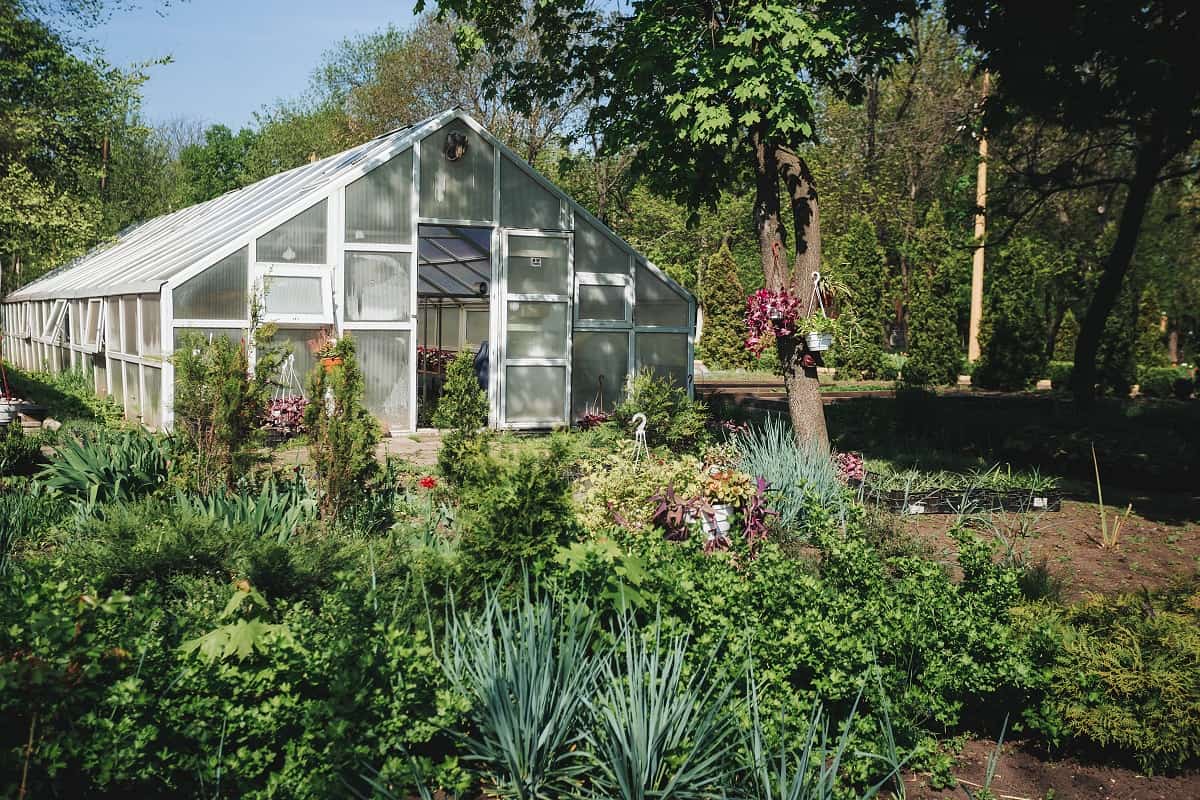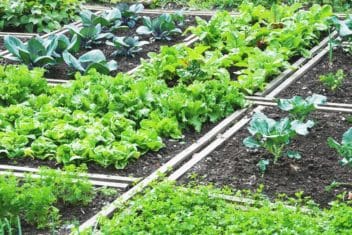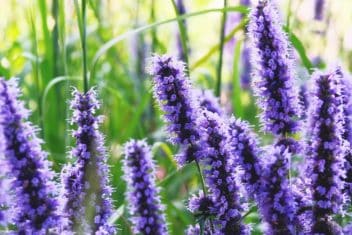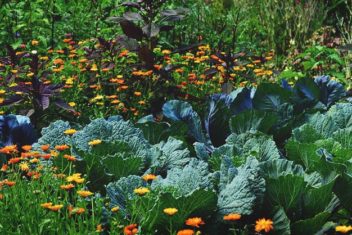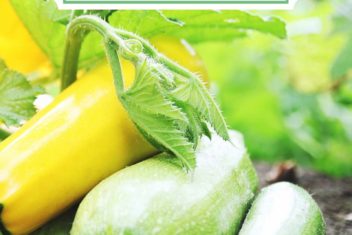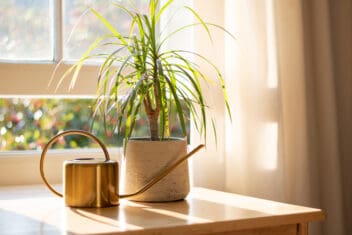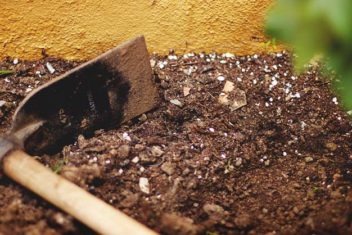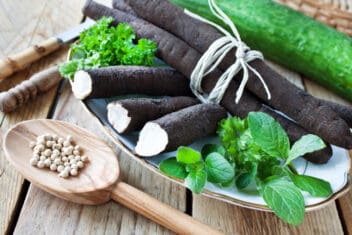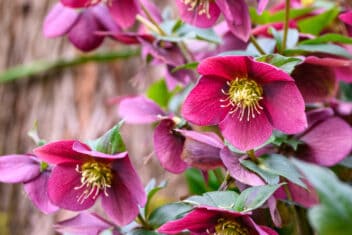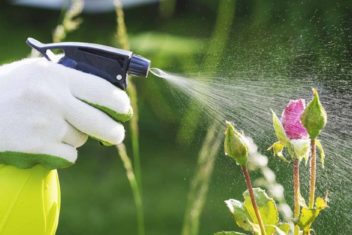Gardening in a greenhouse, hoop house, or other covered structure has many similarities to gardening outdoors. Basic gardening skills such as how to start seedlings, knowing when to transplant, and regular plant care still apply. However, there are also some huge differences you need to know about for good production.
For example, things like air exchange, light transmission, and climate control are completely different when gardening in greenhouse spaces. If you want to delve deeper into some of those details, to fine-tune your greenhouse gardening, then read on.
About Greenhouse Gardening
In this post, I’m using the term “greenhouse” generically to describe any structure that allows sunlight to pass through while limiting airflow. So, this information also applies to gardening structures such as a conservatory, hoop house, walipini, or even a cold frame.
These kinds of environments vary from each other in many ways. Still, they are more alike than different when it comes to growing plants inside them. Let’s look at 3 of the special skills you’ll need and how to get them.
Fresh Air Management

As soon as you put a cover over something, the amount of fresh air allowed in that covered space is reduced. So, in a covered growing space it’s critical to compensate for the reduction of fresh air by bringing it in on purpose.
1. Human Safe Buildings Comparison
In our homes, builders ensure sufficient air circulation with heating and cooling systems that draw in fresh air. Windows and doors are also sources of fresh air. Electric vents remove noxious gases in bathroom and kitchen areas.
Roofs contain passive and powered vents that release toxic air as warm air rises. Plus, we have carbon monoxide detectors and air filters or purifiers to keep air quality safe in our homes. So, we never really have to think about fresh airflow.
These things automatically ensure that the carbon dioxide and other gasses we produce while breathing, cooking, using cleaning products, or otherwise occupying our homes don’t become dangerous to us.
2. Airflow
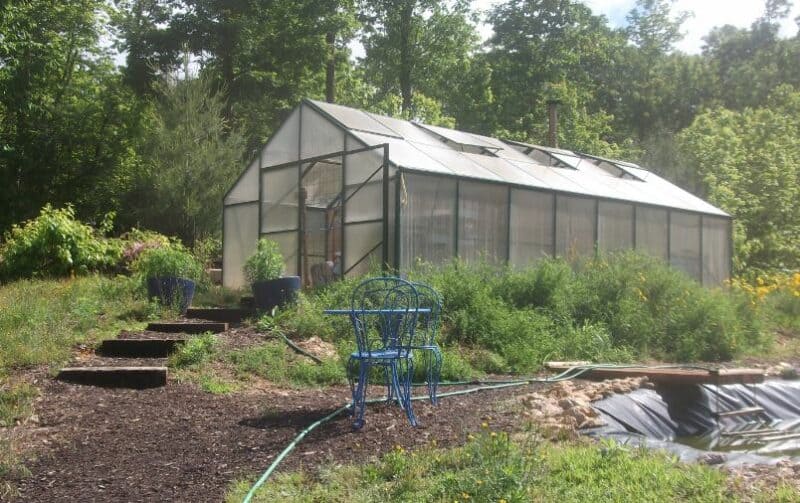
Well, plants in a greenhouse also need their fresh air intake managed just like we do. However, unlike our homes, most non-commercial greenhouse models don’t come with automated, integrated fresh air intake mechanisms.
In fact, backyard greenhouses typically rely solely on the user to open and close windows or doors to bring in air as required. As such, one of the first skills you’ll need to learn is how and when to supply regular fresh air while also maintaining a stable climate inside a greenhouse.
3. Plants Need “Air”
People often say that plants take in carbon dioxide and release oxygen when talking about photosynthesis. However, the reality is that plants actually breathe the same “air” as humans do – and not just carbon dioxide.
There’s no easy answer on how much fresh air to bring in on a given day. It’s always a delicate balance between climate control and air exchange. Still, when you understand the factors that influence how much air plants use, you can develop a knack for safely and effectively airing your greenhouse.
Here are some factors to consider.
– Air Capacity
The size and available air space in your greenhouse control how much air you have available for plants inside. For example, a cold frame sitting on top of a garden bed has very little air capacity. By contrast, a 12 x 36-feet greenhouse with a 12-feet ceiling height will have a lot more available air at any given time.
As such, you may need to open the cold frame more frequently than a large greenhouse to refresh the air.
– Air Gaps
Also, some structures are better sealed than others. Greenhouse kits with built-in doors and windows often have small air gaps around window openings and doorways.
Meanwhile, a well-built DIY cold frame is often better sealed than a large greenhouse kit. Smaller, custom-built greenhouses too tend to be better sealed than generic kits.
The more airtight a structure is, the more frequently you’ll need to open doors, windows, or vents.
4. Plant Capacity
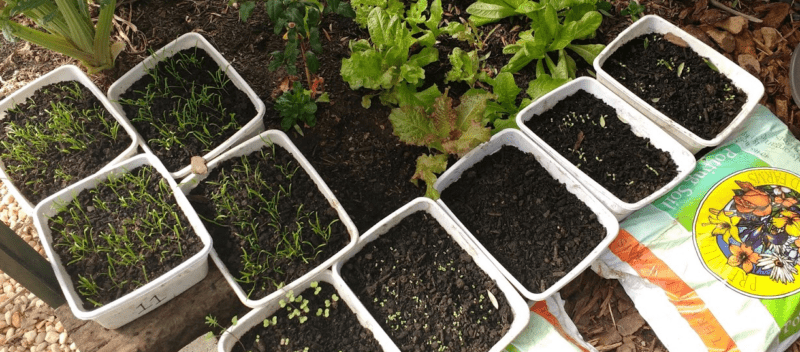
The number of plants in your space will also influence air exchange. If your greenhouse is crammed to the hilt year-round (like mine is), you’ll need more fresh air daily.
If you are just using your greenhouse to start seedlings and overwinter a few pots, those plants won’t utilize as much air as a full garden of actively growing greenhouse plants would.
5. Soil Quantity/Type
Soil also has air requirements. Bacteria, fungi, and other life forms like worms also use air.
If you have inground beds and large containers of actual “soil” (e.g. with compost, clay, sand, etc.) your air needs will be high. However, if you are seed starting in a soilless planting medium and using peat-based potting mix to prepare transplants – your potting mixes won’t have the same air needs as life-rich soil.
6. Temperature and Light
Air temperature and intensity of light also play key roles in determining how frequently you need to intake fresh air. In high temperatures, plants transpire more. That means they require more fresh air for that process.
Also, on sunny days and times of the year when the days are longer, plants do more photosynthesizing. They also need lots more air for that process.
In cool weather, on shady days, or in winter when days are shorter – plants won’t use as much fresh air for their sugar production process or to cool themselves.
7. Plant Type
Additionally, plants known for their “air purification” abilities may require more fresh air than tropical plants adapted to grow in high humidity. Bog plants suited to grow in low oxygen soil conditions won’t need as much air as plants that thrive in loose, light, air-filled soils.
Fast-growing plants need more air than slow-growing plants. Plus, plants grow at different rates in different seasons. Cool-season plants need more fresh air in cool weather. Warm-season plants need more air as temperatures rise.
8. Heat Source
The type of heat source you choose for your greenhouse also determines how much fresh air you need to supply.
– Electric Heaters
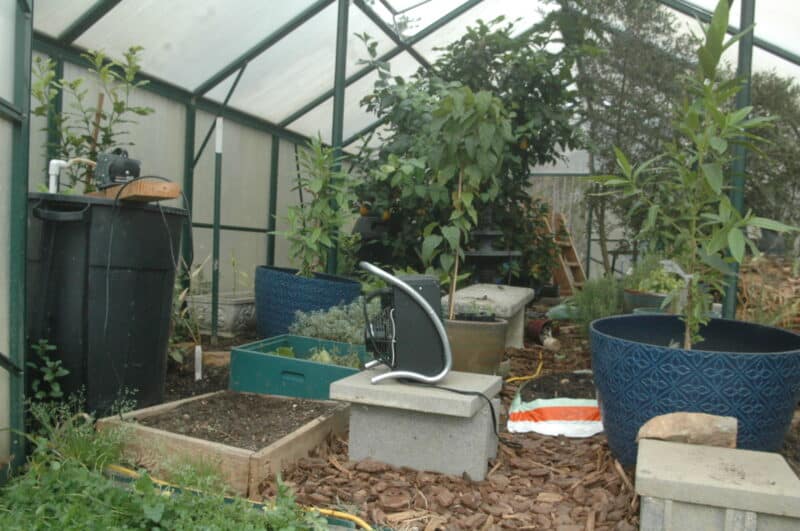
Electric heaters have the lowest fresh air requirements. However, they are generally only effective and cost-efficient for very small greenhouses or infrequent use.
– Fuel-Based Heaters
Heaters that run on a fuel source such as propane, natural gas, kerosene, or paraffin are more economical to operate. Still, they require a constant turnover of fresh air to prevent toxic gas accumulations. Otherwise, plants may not flower and will likely grow slower.
Expensive commercial models rely on automated vents to draw in fresh air and release toxic gas build-up. However, smaller greenhouse models don’t include vents.
If you choose a model without a built-in vent, be extra careful to ensure good ventilation. Otherwise, you could run serious risks for combustion hazards, toxic gas build-up, and unsafe air for you and your plants.
Light
Now, let’s talk about light. The coverings used to create more regulated climate control inside a greenhouse also reduce the quantity of sunlight that reaches your plants.
The exact amount of light lost as it passes through the coverings varies by material. In general, though, the loss of light rays is somewhere between 20-50%. That’s a lot of lost light compared to growing in direct sun outside.
For some plants that don’t love full sun, this light reduction can be a benefit. However, for plants adapted to full sun, such as many vegetables and fruits, it can be a big adjustment.
1. Greenhouse Adapted Plants
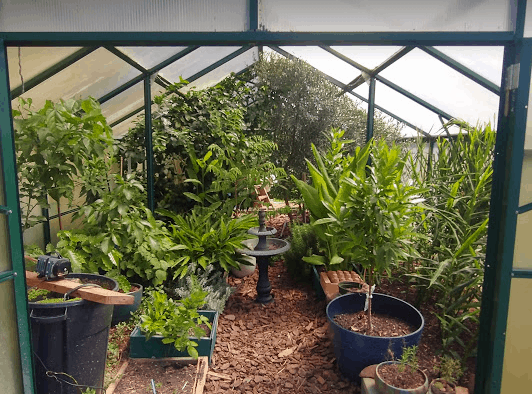
That’s why you’ll get better results if you plant seeds and grow plants that are specifically adapted for greenhouse growing. Here are some ways to identify plants that will grow well in a greenhouse.
- Commercial seed sellers often note the varieties that work best in greenhouses in their catalogs or care instructions. You can also ask for recommendations
- Plant descriptions like “great for a sunny window,” or “indoor/outdoor,” and “bright, filtered light” are helpful to identify plants that will likely be happy in a greenhouse
- Plants you buy from a greenhouse nursery are also great options for growing in your home greenhouse
2. Location
Additionally, just like in your garden, some parts of your greenhouse may be sunnier than others. So, locating plants in the spot that best matches their sun needs is key.
For plants that need maximum light, keep them out of the shade of other plants or any structures such as potting tables in your greenhouse. Also, move them toward the south side of your greenhouse for maximum sun exposure.
Plants that can tolerate shade are perfect for locating under other plants with shade-providing leaves. They also tend to grow better on the north side of a greenhouse.
Climate
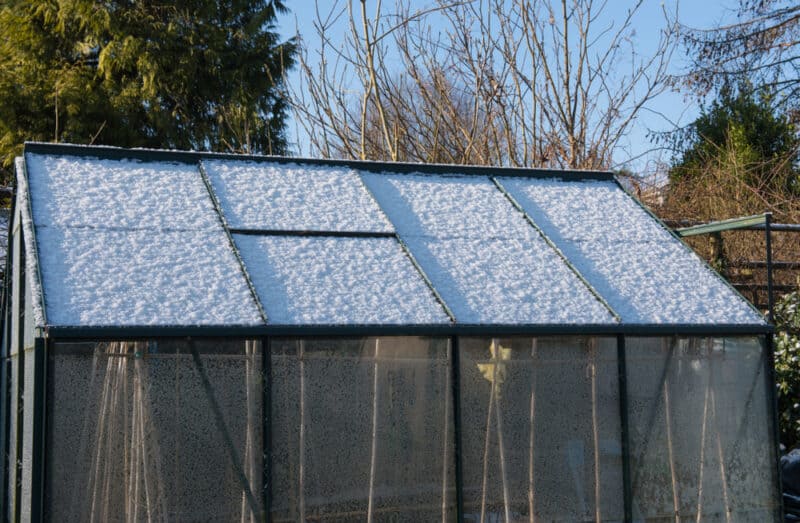
Now let’s talk about the climate inside of a greenhouse. One of the main reasons to grow in a greenhouse rather than in a garden is to provide more warmth in winter. However, gardening in a greenhouse doesn’t automatically guarantee the right climate.
The greenhouse structure is just one of many tools that you’ll need to use to create the ideal conditions of warmth and coolness throughout the year.
1. Winter Greenhouse Temperatures
At night and on shady days, depending on materials used, a greenhouse will only offer you about 5-10°F of cold protection compared to outside temperatures. That means if it’s 8°F outside, your greenhouse will still be well below the 24°F threshold considered detrimental to many plants.
– Cold-Hardy Season Extension
As such, an unheated greenhouse in areas with sub-freezing winters is only suitable for cold-hardy plants. It extends their season further into winter by preventing freezing wind damage and keeping frost from settling.
On hot sunny days, though, unless you let in lots of fresh air, your greenhouse can become too hot for cold-hardy plants. So, you also need to make a plan to bring in cold air on hot days.
Overall, greenhouses used for cold-hardy plants work best in cold climates. For marginal climates, like my cold-hardiness zone 7A, it’s hard to keep the soil cool enough for cold-hardy plants. I find it much easier to grow cold-hardy plants outside with floating row covers.
– Non-Cold Hardy Overwintering
If you plan to use your greenhouse for plants that aren’t cold-hardy, your winter climate will dictate how much heat and what other tools you need to employ to keep plants safe and warm.
A well-insulated greenhouse, such as one with twin-wall polycarbonate panels will gain you about ½ USDA hardiness zone. So, for example, I’m in Zone 7A. However, when not heated on a shady winter day, my greenhouse is like zone 7B.
That makes plants like artichoke, ashitaba, and galangal possible to grow. Still, it won’t keep cardamom, cinnamon, or vanilla alive through winter. For that, a greenhouse heater and other various heat-making and heat-sinking tools are necessary to create microclimates.
2. Excess Heat
Another huge problem in a greenhouse is that a little sun generates a lot of heat inside those spaces. So, even in freezing conditions, your greenhouse can be above 100°F in no time when windows and doors are closed.
Automatic window openers on timers, or that use heat triggered wax expansion technology, are good options if you can’t manually open windows in time each day. Also, regular visits to check air temperatures and open doors can be necessary.
Practical Example of Greenhouse Management
I know this is a lot to put together. So, let me give you a practical example of how I maintain my 12 x 36-feet, perennial plant loaded greenhouse to simulate a tropical environment in a USDA zone 7A climate.
1. Airflow
In summer all my windows and doors are open at sunrise to allow for maximum airflow.
From fall through spring, on sunny days, I open at least one window during daylight hours. Generally, though, I open several windows and sometimes a door to keep the greenhouse close to about 70°F throughout those seasons.
On cloudy, rainy, snowy, or cold windy days, I only open a single-window if temperatures inside the greenhouse surpass 55°F. Otherwise, me opening the door and visiting my plants is the only fresh air source they get for that day.
2. Light
To manage my light conditions, I grow mostly “understory” plants that evolved to grow below other plants in a forest or jungle. For example, vanilla, black pepper, cardamom, galangal, ginger, coffee, tea, and turmeric all grow well in greenhouse light on both the north and south sides of the space.
I also grow a few citrus plants like Meyer Lemon, Kaffir lime, Calamondin Orange, Key Lime, and others that prefer full sun. So, those live on my southside with unobstructed direct light.
Patchouli, tamarind, lemongrass, rosemary, capers, and avocados also get the most light I can give them. I also occasionally turn their pots to get them more direct morning light for best results.
3. Climate Control
For heat in winter, I keep my greenhouse at 50°F most nights. Occasionally though, it dips a little lower. To do this I use the following mix of tools.
- An electric heater on the tropical plant side of my greenhouse,
- A wood-fired hot tub on the non-tropical plant side of my greenhouse,
- Multiple heat sinking water drums throughout the greenhouse,
- Strawbale insulation on the north side to reduce wind chill,
- Careful timing of when I allow fresh air in (as described under the airflow section), and
- Closing the greenhouse several hours before dark to trap in daytime heat.
Additionally, I do the following to create microclimates for tropical plants:
- Group these plants together nearest to the heater and furthest from the outer greenhouse walls,
- Keep a hot compost pile going on the Northside behind these plants,
- Insulate the root system of less mature plants by putting a small pot in a large pot to create an envelope of heat around the root zone, and
- Wrap plants with additional plastic sheeting on the coldest nights to preserve more heat directly around plant leaves.
Final Advice on Greenhouse Gardening
I fine-tuned my techniques for growing in a greenhouse while I was doing the gardening for my book Grow Your Own Spices. Having to do all that research provided great motivation for spending lots of time in the greenhouse understanding how plants grow in different conditions.
That experience reminded me that one of the fastest ways to get good at something is to do it every day. So, if you want to get good at greenhouse management quickly, spend as much time with your plants as you can.
Set up a seating area so you can stay a while. Take notes. Try plants in different locations. Notice where they seem happiest.
It can take a year or two of gardening through the seasons to perfect your greenhouse air, light, and climate management skills. However, once you do, you’ll truly understand William Cowper’s quote “Who loves a garden loves a greenhouse too.”
